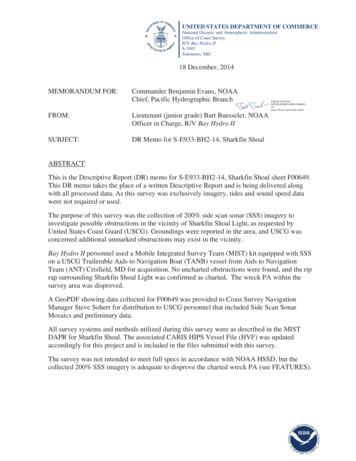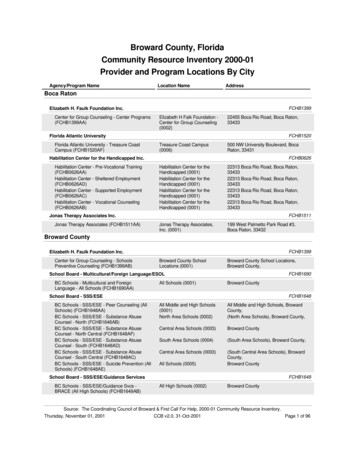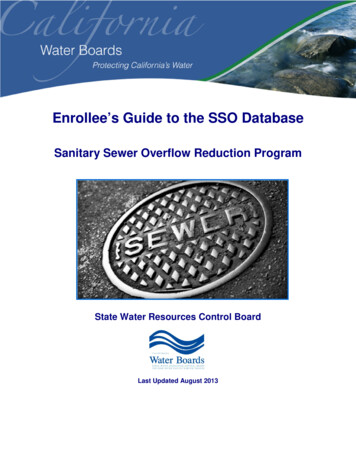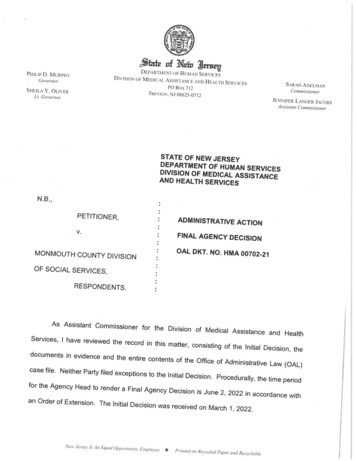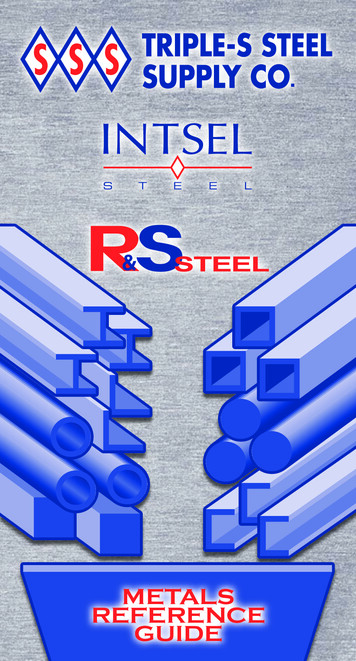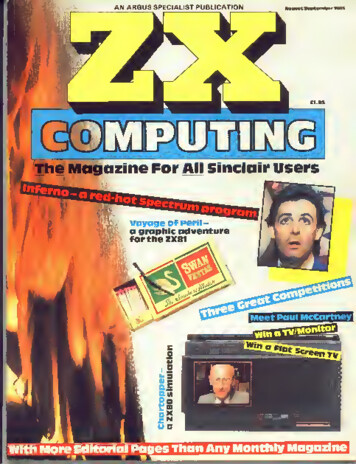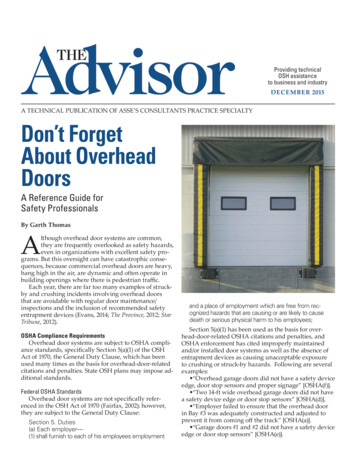
Transcription
Providing technicalOSH assistanceto business and industrydecember 2015A TECHNICAL PUBLICATION OF ASSE’S CONSULTANTS PRACTICE SPECIALTYDon’t ForgetAbout OverheadDoorsA Reference Guide forSafety ProfessionalsBy Garth ThomasAlthough overhead door systems are common,they are frequently overlooked as safety hazards,even in organizations with excellent safety programs. But this oversight can have catastrophic consequences, because commercial overhead doors are heavy,hang high in the air, are dynamic and often operate inbuilding openings where there is pedestrian traffic.Each year, there are far too many examples of struckby and crushing incidents involving overhead doorsthat are avoidable with regular door maintenance/inspections and the inclusion of recommended safetyentrapment devices (Evans, 2014; The Province, 2012; StarTribune, 2012).OSHA Compliance RequirementsOverhead door systems are subject to OSHA compliance standards, specifically Section 5(a)(1) of the OSHAct of 1970, the General Duty Clause, which has beenused many times as the basis for overhead-door-relatedcitations and penalties. State OSH plans may impose additional standards.Federal OSHA StandardsOverhead door systems are not specifically referenced in the OSH Act of 1970 (Fairfax, 2002); however,they are subject to the General Duty Clause:Section 5. Duties(a) Each employer—(1) shall furnish to each of his employees employmentand a place of employment which are free from recognized hazards that are causing or are likely to causedeath or serious physical harm to his employees;Section 5(a)(1) has been used as the basis for overhead-door-related OSHA citations and penalties, andOSHA enforcement has cited improperly maintainedand/or installed door systems as well as the absence ofentrapment devices as causing unacceptable exposureto crushing or struck-by hazards. Following are severalexamples: “Overhead garage doors did not have a safety deviceedge, door stop sensors and proper signage” [OSHA(f)]. “Two 14-ft wide overhead garage doors did not havea safety device edge or door stop sensors” [OSHA(d)]. “Employer failed to ensure that the overhead doorin Bay #3 was adequately constructed and adjusted toprevent it from coming off the track” [OSHA(a)]. “Garage doors #1 and #2 did not have a safety deviceedge or door stop sensors” [OSHA(e)].
The Advisor OSHA abatement typically instructs to “hire aprofessional to install the safety devices and conductperiodic inspections” [OSHA(b)(c)].State OSH PlansState OSH plans must, by OSHA requirements, be at least aseffective as federal standards, but having satisfied that requirement, they are free to be more specific about overhead doorsafety standards and practices. For example, Minnesota (Minnesota Department of Labor & Industry) provides more specificinstructions on acceptable overhead door safety options.How to Properly Include Overhead Doors in a Safety ProgramTo comply with OSHA regulations and minimizerisk, a planned maintenance and compliance programshould be implemented for overhead doors that meetsthe following standards. Inspection, maintenance andrepair work is typically performed by a qualified overhead door service company.Standard #1: Maintenance Practices & IntervalsAll door systems should be installed, inspected andmaintained in accordance with the manufacturer’s specifications. This includes maintenance intervals, which canvary depending on daily cyclage and operating environment. If the manufacturer’s specifications are not available, then the preventive maintenance program shouldadhere to established industry standards/best practices[e.g., Door & Access Systems Manufacturers Association].Standard #2: Entrapment DevicesAll motorized door systems should be equipped withentrapment devices to manufacturer’s specifications,such as photo-eyes or sensing edges. If there are doorsystems equipped with older devices not current withnewer, improved safety standards, modernizing shouldbe considered where reasonably practicable, for example,upgrading to monitored entrapment devices.Standard #3: Documentation & ReportingThorough, secure documentation should be maintained that details: maintenance and service work performed; problems or deficiences found, preferably documented with notes and photographs, corrective actionrecommended and corrective action taken; practices and standards used to inspect and maintain doors (e.g., manufacturer’s operating/maintenancemanuals or similar documentation).money well-spent. A thorough maintenance servicetakes a qualified door dealer about 45 ( 15) minutes perdoor; this service typically should be performed onceor twice per year. Depending on local rates, the cost forservicing most doors systems is between 50 and 100.Beyond mitigating safety risk and meeting OSHAcompliance requirements, properly maintaining doorsystems has the added benefit of being cost-effective inits own right. Most commercial doors are made withsmall, inexpensive components that wear, fatigue, andrequire checking and replacement during a door system’s normal life cycle. While regular maintenance is nota guarantee against future problems, finding and fixingsmall problems, such as frayed cables or worn rollers,before they become big problems, such as a door thatfalls, usually results in significant cost savings.Sectional Overhead DoorsHow They WorkSectional doors (Figure 1) are constructed of door sections, usually 24 in. high, which are stacked one on topof another and fastened together with hinges. The doorarticulates as it opens and closes, with its path guided byrollers that travel in steel tracks secured to the building.Sectional doors utilize a simple counterbalancesystem in which the weight of the door is offset by thepotential stored energy of a pre-wound torsion spring.The torsion spring helps rotate the torsion shaft anddrums, which in turn spool the lifting cables (also attached to the door’s bottom brackets) to lift the door.The torsion assembly and related components areunder extreme tension.What You Need to Know1) Many door components, such as hinges, bearings,cables and rollers wear and fatigue with use, and requireroutine replacement. Left uncorrected, problems withFIGURE 1Sectional Door ComponentsCost to Implement a Preventive Maintenance& Safety Compliance ProgramUnless there are serious problems, properly maintaining door systems is not expensive and is certainlydece m ber 20152
The Advisorsmaller components can escalate into larger problems thataffect the overall performance and safety of the door.2) Sectional doors can become dangerous if the counterbalance system is compromised (e.g., lifting cablesbreak, become unspooled from the drums, or detachfrom the bottom brackets). If this occurs when the dooris in an open position, the door can be at risk of falling.3) There are several accessories available for sectionaldoors to improve safety: safety bottom brackets, springfailure safety devices and cable tension springs.ComponentsBottom brackets anchor the lifting cables to the door.They are under significant tension from the counterweight forces of the torsion springs and it is importantthat they be securely fastened to the door.Cables support the entire weight of the door and areunder tension from the torsion springs. Undersized orfrayed cables can break, leaving one or potentially bothsides of the door unsupported. It is common for cables toneed replacing several times over a door’s life.Rollers guide the door in the tracks. It is commonfor rollers to wear and need replacing. Failed rollers canpotentially impede the free movement of the door andcause it to jam in its tracks.Tracks, brackets, back-hanging position and supportthe door to the building structure. Ceiling support of thetracks, called back-hanging, is especially important as itsupports the door in the fully open position.Hinges connect the sections of the door and allowarticulation. Poorly secured or aligned hinges can causeimproper door movement and damage to sections orother parts of the door system.Span braces and struts attach across the width of thedoor to provide lateral stiffness. Without proper spanbrace support, a door can be vulnerable to bowing orhigh wind conditions, both of which can cause a door todislodge from its tracks.Torsion springs provide the counterbalance force to theweight of the door and possess a large amount of storedmechanical energy. Broken torsion springs cause abnormalloading on door and electric operator components. Mosttorsion springs are rated for 10,000 cycles-to-failure andwill likely need to be replaced at least once during a door’slife. It is generally not possible to determine how manycycles are left in a torsion spring by visual inspection.Torsion shaft, drums and bearings are the mechanical andstructural components of the torsion assembly. Potential problems include failed bearings, worn shafts, misalignments, loosecouplers, improperly secured brackets and cracked drums.Pusher springs, bumper springs and stops preventthe door from running off the end of the tracks. Pushersprings are installed to maintain cable tension on certaindoor configurations.FIGURE 2Rolling Steel Door ComponentsInterlocks should be installed on doors with locksand motorized operators to prevent the operator fromattempting to open the door when it is locked.Rolling Steel Service DoorsHow They WorkRolling steel doors are constructed of many individual steel slats, usually 2 to 3 in. high, which attach to eachother and create a continuous vertical curtain. The curtain/slat assembly travels in channels in the door guideslocated on either side of the door and rolls up into thehead assembly where it wraps around a barrel.The weight of the curtain is counterbalanced by a torsion spring located inside the barrel. The balance of thedoor is adjusted using the tension wheel located at theend of the barrel assembly, which increases or decreasesthe tension on the spring.Rolling steel service doors are often used in applications that require greater security, where insulationvalue is not critical or where there are space constraints.What You Need to Know1) Torsion springs are a critical component of the doorand special care should be taken to ensure that they aretensioned properly and replaced before they fail. Mosttorsion springs are designed with a life span of 10,000 or20,000 cycles, after which time they are prone to failure.Implementing a program of proactive spring replacement can reduce operational disruptions related toemergency spring failures.2) Safety inertia brakes can prevent the door fromsuddenly falling in the event of a torsion spring failure.ComponentsBarrel assembly/torsion springs provide the counterbalance force to the weight of the door, lessening the forceneeded to open and close the door. The torsion spring is located inside the barrel assembly, limiting access and makingdece m ber 20153
The Advisorvisual inspections impractical. Torsion springs are typicallyrated 10,000 or 20,000 cycles-to-fail, making it important totrack door usage to replace the spring before it fails.A tension wheel is the component used to adjust thetorsion springs balance. Adjusting the wheel will eitherincrease or decrease tension on the doors torsion spring.The tension wheel is a direct connection to the torsionspring and possess a large amount of mechanical energy. If the tension wheel becomes loose or the mechanical connection to the spring is lost the operator will besubject to abnormal loading.An inertia brake prevents the door from free-falling bystopping the door’s movement if a maximum RPM thresholdis reached. Some inertia brakes work by communicating withthe operator and some physically lock the shaft in place. Aninertia brake that physically stops the shaft can only be triggered so many times before needing replacement.Endlocks/windlocks lock individual slats into theguides. Broken or loose endlocks can interfere with doormovement by catching in the guides.Stops physically prevent the door from runningbeyond the upper or lower limits. Stops are used alongwith limit switches to ensure that the door does notoverrun the guides.A hood protects the curtain as well as shields movingcomponents of the door from the elements. A damaged hoodcan interfere with the curtain and potentially damage it.Guides are the channels in which the curtain moves. Itis important that the gap between guides is correct and thecurtain is able to move freely. Obstructed movement due todamaged guides can exert an abnormal load on the operator.Motorized Door OperatorsHow They WorkBecause of their size and weight, many commercialoverhead doors are equipped with motorized, electricoperators. The most common type is a hoist (jackshaft)operator, which mounts near the torsion assembly andopens/closes the door by rotating the torsion shaft.Operators can be controlled by various devices invarious ways: push-button wall stations, remote controltransmitters, timers, ground loops, etc. For convenience,many operators are programmed to close automatically(e.g., timers), semi-automatically (e.g., momentary pressure to close on a push-button station), or by radio controls (e.g., handheld remotes). Doors operating in thesemodes create entrapment risk and should equipped withentrapment devices that reverse the door’s directionshould it encounter an obstruction while it is closing.Entrapment DevicesPhoto-eyes emit a small light beam from a transmitter to a receiver across the width of the door opening ata height of 6 in. from the floor. If the light beam is inter-FIGURE 3Photo-EyesFIGURE 4Sensing Edgesrupted when the door is closing, the operator reversesthe door and holds it in a fully open position.Photo-eyes can be monitored or non-monitored depending on their capabilities and the capabilities of theoperator. Monitored means the proper functioning ofphoto-eyes is frequently checked by the operator’s electronics and, should a problem be detected, the operatorreverts to a safe mode restricting how the door can beclosed. Non-monitored photo-eyes are not self-checkingand therefore offer a reduced level of safety.Sensing edges are positioned on the bottom, leadingedge of the door and can detect physical contact withan object. If the sensing edge comes into contact withan object while the door is closing, a signal is sent to theoperator to reverse the door to the fully open position.Like photo-eyes, sensing edges can be monitoredor non-monitored depending on their capabilities andthose of the operator.What You Need to Know1) Entrapment devices are a critical safety componentof motorized door systems. Their proper specification,installation and function are a core safety and compliance concern. Wherever reasonably practicable, doorsshould be equipped with monitored entrapment devices.2) Modes of control affect entrapment device standards.The more hands-off the door’s operation (e.g., automatic timer control), the higher the standard for entrapment devices.3) All operator manufacturers call for (at a minimum)monthly checks of entrapment devices. These checksshould be a routine part of a safety program.What Now? Next StepsDo not ignore door systems. Neglected doors simplybecome less reliable and potentially more hazardousover time. Take action by having a qualified door dealerperform an initial inspection and service to establish abaseline of door condition, performance and safety compliance. Then, take it from there.Ensure that the dealer can perform and documentmaintenance work to meet the standards describeddece m ber 20154
The Advisor(i.e., maintenance practices and intervals; entrapmentdevices; documentation and reporting), as these are thestandards that matter for safety compliance and doorreliability. nReferencesEvans, T. (2014, Oct. 8). Jury awards 21.3 million to Indy maninjured in garage door accident. IndyStar.Fairfax, R.E. (2002, Sept. 10). Letter of interpretation. Washington, DC: Department of Labor, OSHA.Minnesota Department of Labor and Industry. Clarification ofMinnesota Rules 5205.0675, subp. 2—Overhead doors (Factsheet). St. Paul, MN: Author.OSHA(a). Inspection No. 313525404, Cema Corp.OSHA(b). Inspection No. 313993313, Kelly Lumber Sales Inc.OSHA(c). Inspection No. 313993321, Timber Express Inc.OSHA(d). Inspection No. 314071929, Orland Dwelley & Sons Inc.OSHA(e). Inspection No. 314071838, Force Manufacturing Inc.OSHA(f). Inspection No. 314223140, Shelburne Fire Department.OSHA(g). Inspection No. 314365602, Employee dies whencrushed beneath garage door.OSHA(h). Inspection No. 316106731, Employee dies after being struck by door.The Province. (2012, Oct. 13). Garage door that nearly crushedworker to death at Vancouver works yard not properly maintained: WorkSafe BC.Star Tribune. (2012, Mar. 11). State cites nine employers forworkplace deaths.Garth Thomas is president of Safedoor Planned Maintenance Ltd. (www.safedoorpm.com), which providesplanned maintenance and safety compliance softwareto the overhead door industry. istockphoto.com/benkrutEach year, there are far too manyexamples of struck-by and crushingincidents involving overhead doorsthat are avoidable with regular doormaintenance/inspections and theinclusion of recommended safetyentrapment devices.dece m ber 20155
The Advisor Resourcesn Consultants Informationn International Resource GuideSearch ourknowledge basen Journal of SH&E ResearchNetwork onLinkedInn Networking Opportunitiesn Professional Safety Journaln Publication OpportunitiesFind us onFacebookFollow us onTwittern Volunteer OpportunitiesReadASSE’s blogWhen you see this symbol,click it to learn moreThe Advisor Consultants Practice SpecialtyOfficersAdministratorBrian E. Hitt, CSP, CHMMhitt2010@att.netAssistant AdministratorCarol A. Keyes, CSPcarkey@chess-safety.comContent CoordinatorKim Marie Lyonsklyons@amhealthandsafety.comThe Advisor is a publicationof ASSE’s Consultants PracticeSpecialty, 520 N. NorthwestHighway, Park Ridge, IL 60068,and is distributed free of chargeto members of the ConsultantsPractice Specialty. The opinionsexpressed in articles herein arethose of the author(s) and are notnecessarily those of ASSE. Technicalaccuracy is the responsibility of theauthor(s). Send address changes tothe mailing address above; via faxto (847) 768-3434; or via e-mail tocustomerservice@asse.org.ASSE StaffManager, Practice SpecialtiesCharlyn Haguewoodchaguewood@asse.orgCommunications TeamTina AngleyCathy BakerBrendan HilliardSiobhan LallyTim ShaunnesseySue TrebswetherCOPSpublications@asse.orgdece m ber 20156
"Overhead garage doors did not have a safety device edge, door stop sensors and proper signage" [OSHA(f)]. "Two 14-ft wide overhead garage doors did not have a safety device edge or door stop sensors" [OSHA(d)]. "Employer failed to ensure that the overhead door in Bay #3 was adequately constructed and adjusted to

